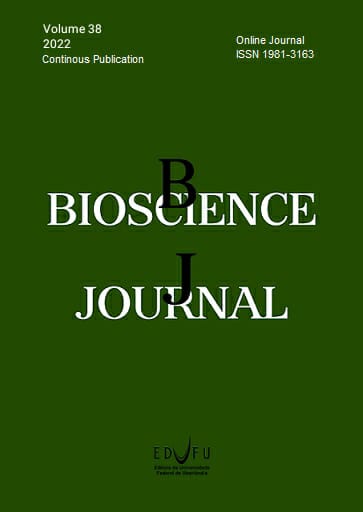Physical attributes and organic material in pastures of Brachiaria brizantha at degradation levels
DOI:
https://doi.org/10.14393/BJ-v38n0a2022-54529Keywords:
Soil physical atributtes, Soil organic matter, soil water, soil qualityAbstract
Pastures cover, in Brazil, around 165 million ha, most of them are at some degradation level. Recovering these pastures is essential. The objective of this study was to evaluate the sensibility of soil organic matter (SOM) and its physical attributes in pasture soil at different degradation levels (1 to 4), Capoeiras (1 and 2) and secondary Forest (Control). Samples were collected at four depths (0.00-0.05, 0.05-0.10, 0.10-0.20 and 0.20-0.40 m). We verified higher values for SOM and hydraulic conductivity (Ko) in Forest, especially in the most superficial layer (0.00-0.05). We noted low values for macroporosity in this area. In all areas under Pastures lower values for Ko were observed in the superficial layer (0.00-0.05 m) when compared to layers 0.05-0.10 and 0.10-0.20 m, which indicates that the pasture management and cattle trampling negatively affect the physical quality of the pastures. For field capacity and wilting point the average values were observed in Pasture 4 (more degraded), which caused higher values for water availability. According to the principal components analysis, except for SOM at 0.20-0.40 m, all variables studied presented correlation above 0.6. From grouping analysis, we separated 3 groups: Forest; Capoeiras 1 and Capoeira 2 and Pastures 1 to 4.
References
AGUIAR, M.I., et al. Sediment, nutrient and water losses by water erosion under agroforestry systems in the semi-arid region in northeastern Brazil. Agroforestry Systems. 2010, 79(3), 277–289. https://doi.org/10.1007/s10457-010-9310-2
BOMBINO, G., DENISI, P., GOMEZ, J.A. and ZEMA, D.A. Water Infiltration and Surface Runoff in Steep Clayey Soils of Olive Groves under Different Management Practices. Water. 2019, 11(240), 1-13. https://doi.org/10.3390/w11020240
BLANCO-CANQUI, H., et al. Soil carbon increased by twice the amount of biochar carbon applied after 6 years: Field evidence of negative priming. GCB Bioenergy. 2020, 12, 240-251. https://doi.org/10.1111/gcbb.12665
CALEGARIO, A.T., et al. Mapping and characterization of intensity in land use by pasture using remote sensing. Revista Brasileira de Engenharia Agrícola e Ambiental. 2019, 23(5), 352-358. https://doi.org/10.1590/1807-1929/agriambi.v23n5p352-358
CENTENO, L.N., et al. Dominant Control of Macroporosity on Saturated Soil Hydraulic Conductivity at Multiple Scales and Locations Revealed by Wavelet Analyses. Journal of Soil Science and Plant Nutrition. 2020, 20, 1686–1702. https://doi.org/10.1007/s42729-020-00239-5
DIAS FILHO, M.B. Estratégias de recuperação de pastagens degradadas na Amazônia brasileira. Embrapa Amazônia Oriental-Documentos (INFOTECA-E), 2015.
EMPRESA BRASILEIRA DE PESQUISA AGROPECUÁRIA – EMBRAPA (a). Centro Nacional de Pesquisa de Solos. Sistema brasileiro de classificação de solos. 5th ed. Rio de Janeiro, 2018.
EMPRESA BRASILEIRA DE PESQUISA AGROPECUÁRIA – EMBRAPA (b). Centro Nacional de Pesquisa de Solos. Manual de métodos de análise de solos. 3rd ed. Rio de Janeiro, 2017.
HENCHIO, M., et al. Future Protein Supply and Demand: Strategies and Factors Influencing a Sustainable Equilibrium. Foods. 2017, 6(7), 53. https://doi.org/10.3390/foods6070053
JAT, M.L., et al. 2018. Soil Processes and Wheat Cropping Under Emerging Climate Change Scenarios in South Asia. In: SPARKS, D. L. (ed.). Advances in Agronomy. New York: Academic Press, pp. 111-171.
JIEN, S.H. and WANG, S.S. Effects of biochar on soil properties and erosion potential in a highly weathered soil. Catena. 2013, 110, 225–233. https://doi.org/10.1016/j.catena.2013.06.021
MAPBIOMAS – Plataforma MAPBIOMAS v.4.1. Available: https://plataforma.mapbiomas.org/map#coverage
OLIVEIRA, J.B. Pedologia aplicada. 4 ed. Piracicaba: FEALQ, 2007.
OLIVEIRA, M.L. Camadas superficiais adensadas em resposta a radiação solar, temperatura e umidade do solo. Viçosa: Universidade Federal de Viçosa, 2000. Tese de doutorado.
PERREIRA, L.F., FERREIRA, C.F.C. and GUIMARAES, R.M.F. Manejo, qualidade e dinâmica da degradação de pastagens na Mata Atlântica de Minas Gerais - Brasil. Nativa. 2018, 6, 370-379. http://dx.doi.org/10.31413/nativa.v6i4.5542
ROCHA JUNIOR, P.R., et al. Soil quality indicators to evaluate environmental services at different landscape positions and land uses in the Atlantic Forest biome. Environmental and Sustainability Indicators. 2020, 7, p100047. https://doi.org/10.1016/j.indic.2020.100047
ROCHA JUNIOR, P.R., et al. Can short-term pasture management increase C balance in the Atlantic Rainforest? Environmental Monitoring and Assessment. 2018a, 190, 190-343. https://doi.org/10.1007/s10661-018-6718-z
ROCHA JUNIOR, P.R., et al. Runoff sediment and P losses from various soil management practices: modelling in hilly slopes. Journal of Soil Science and Plant Nutrition. 2018b, 1, 113-128. http://dx.doi.org/10.4067/S0718-95162018005000502
ROCHA JUNIOR, P.R., et al. Soil, water, and nutrient losses from management alternatives for degraded pasture in Brazilian Atlantic Rainforest biome. Science of the Total Environment. 2017a, 583, 53-63. https://doi.org/10.1016/j.scitotenv.2016.12.187
ROCHA JUNIOR, P.R., et al. Field-based quality indicators in degraded pasture of the Atlantic forest biome. Australian Journal of Crop Science. 2017b, 11, 652-661. https://doi.org/10.21475/ajcs.17.11.06.p326
ROCHA JUNIOR, P.R., et al. Can Soil Organic Carbon Pools Indicate the Degradation Levels of Pastures in the Atlantic Forest Biome? Journal of Agricultural Science. 2014, 6(1), 84-95. http://dx.doi.org/10.5539/jas.v6n1p84
RUIZ, H.A. Material didático da disciplina SOL 640 - Física do Solo. Métodos de análises físicas do solo. Viçosa: Universidade Federal de Viçosa, 2004.
SATTLER, D., et al., 2018. Pasture degradation in Southeast Brazil - Status, Drivers and Options for sustainable land use under climate change. In: LEAL FILHO, W. and ESTEVES FREITAS, L. (Eds.). Climate Change Adaption in Latin America – Managing Vulnerability, Fostering Resilience. Climate Change Management, New York: Springer, pp. 3-17.
SILVA, L.C.R., et al. Unprecedented carbon accumulation in mined soils: the synergistic effect of resource input and plant species invasion. Ecological Applications. 2013, 23, 1345–1356. https://doi.org/10.1890/12-1957.1
TANURE, M.M.C., et al. Soil Water Retention, Physiological Characteristics, and Growth of Maize Plants in Response to Biochar Application to Soil. Soil and Tillage Research. 2019, 192, 164–173. https://doi.org/10.1016/j.still.2019.05.007
TEAGUE, W.R., et al. Grazing management impacts on vegetation, soil biota and soil chemical, physical and hydrological properties in tall grass prairie. Agriculture, Ecosystems and Environment. 2011, 141, 310-322. https://doi.org/10.1016/j.agee.2011.03.009
ZÚÑIGA, F., et al. Temporal dynamics of the physical quality of an Andisol under a grazing system subjected to different pasture improvement strategies. Soil and Tillage Research. 2015, 145, 233-241. https://doi.org/10.1016/j.still.2014.09.014
Downloads
Published
Issue
Section
License
Copyright (c) 2022 Paulo Roberto da Rocha Junior, Guilherme Kangussú Donagemma, Felipe Vaz Andrade, Renato Ribeiro Passos, Fabiano de Carvalho Balieiro

This work is licensed under a Creative Commons Attribution 4.0 International License.





